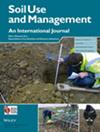量化不同农林系统对喜马拉雅山脉中部土壤碳组分稳定性和长期固碳的影响
IF 3.7
3区 农林科学
Q1 SOIL SCIENCE
引用次数: 0
摘要
土壤有机碳(SOC)是了解农业生态系统碳动态的关键指标。另一方面,碳组分在短时期内更为敏感,可以检测到土壤有机碳库的分布和关系模式的变化。为了验证这一假设,研究人员对 9 个有 16 年树龄的农林系统(AFS)进行了测试,并将 0-15 厘米和 15-30 厘米土壤深度的 K2Cr2O7 可氧化碳(SOC)、pH 值、电导率(EC)、微生物生物量碳(MBC)和碳组分(即极易变(C1frac)、易变(C2frac)、较易变(C3frac)和不易变(C4frac))与对照进行了比较。通过计算碳易变性指数(CLI)和分层率(SR)来评估 SOC 的易变性和垂直分布。研究发现,从种植开始,不同 AFS 的 SOC 储量在 19.82-46.33% 的范围内有显著提高,SOC 固碳量在 0.111±0.002 到 0.697±0.017 MgC ha-1yr-1 之间。在不同的 AFS 中,簕杜鹃在两个土壤深度的 SOC 固碳量都明显高于其他处理。AFS 还显著提高了 SOC 的稳定性,在 0-15 厘米深度,CLI 提高了 0.08-4.48%,在 15-30 厘米深度,CLI 提高了 2.08-18.32%。在不同的 AFS 中,簕杜鹃的 CLI 提高幅度最大,而休耕地的 CLI 提高幅度最小。土壤中碳组分的垂直分布也受 AFS 的影响,如 C1frac 的高 SR 值(1.133-1.203)所示,易溶碳组分主要集中在表土层。微量碳组分与 SOC 呈高度正相关(P < 0.05)(C1frac 的 r=0.872**,C2frac 的 r=0.900** 和 C3frac 的 r=0.915**),表明 SOC 对微量碳具有高度依赖性。研究表明,AFS 有可能显著提高固碳能力,同时也会影响 SOC 的易变性和垂直分布。本文章由计算机程序翻译,如有差异,请以英文原文为准。
Quantifying the impact of different agroforestry systems on soil carbon fractions lability and long‐term carbon sequestration in Central Himalayas
Soil Organic Carbon (SOC) is a key indicator for understanding the carbon dynamics in agroecosystems. Carbon fractions, on the other hand, can be more sensitive over short periods and can detect changes in the distribution and relationship patterns of SOC pools. To test this hypothesis nine, 16‐year‐old agroforestry systems (AFS) were tested and compared with control at 0‐15cm and 15‐30cm soil depths for K2Cr2O7 oxidizable carbon (SOC), pH, Electrical Conductivity (EC), Microbial Biomass Carbon (MBC) and carbon fractions, viz. very labile (C1frac), labile (C2frac), less labile (C3frac), and non‐labile (C4frac). Carbon lability index (CLI) and Stratification Ratio (SR) were calculated to assess the lability and vertical distribution of SOC. The study found that from the time of plantation, SOC stocks significantly improved in the range 19.82‐46.33% under different AFS with SOC sequestration ranging from 0.111±0.002 to 0.697±0.017 MgC ha‐1yr‐1. Among different AFS, Bambusa vulgaris showed significantly higher SOC sequestration than all other treatments at both soil depths. AFS also demonstrated a significant improvement in SOC lability, leading to an increase in CLI by 0.08‐4.48% at 0‐15cm depth and a more pronounced improvement of 2.08‐18.32% at 15‐30 cm depth. Among different AFS the highest improvement in CLI was observed in Bambusa vulgaris and the lowest in fallow land. The vertical distribution of carbon fractions in the soil was also affected by AFS, with the labile carbon fraction mostly concentrated in the topsoil layer as indicated by high SR values (1.133‐1.203) for C1frac. The highly significant positive correlation (P < 0.05) of labile carbon fractions with SOC (r=0.872** for C1frac, r=0.900** for C2frac and r=0.915** for C3frac) indicated the high dependence of SOC on labile carbon. The study revealed that AFS have the potential to significantly enhance carbon sequestration, while also impacting the lability and vertical distribution of SOC.
求助全文
通过发布文献求助,成功后即可免费获取论文全文。
去求助
来源期刊

Soil Use and Management
农林科学-土壤科学
CiteScore
7.70
自引率
13.20%
发文量
78
审稿时长
3 months
期刊介绍:
Soil Use and Management publishes in soil science, earth and environmental science, agricultural science, and engineering fields. The submitted papers should consider the underlying mechanisms governing the natural and anthropogenic processes which affect soil systems, and should inform policy makers and/or practitioners on the sustainable use and management of soil resources. Interdisciplinary studies, e.g. linking soil with climate change, biodiversity, global health, and the UN’s sustainable development goals, with strong novelty, wide implications, and unexpected outcomes are welcomed.
 求助内容:
求助内容: 应助结果提醒方式:
应助结果提醒方式:


